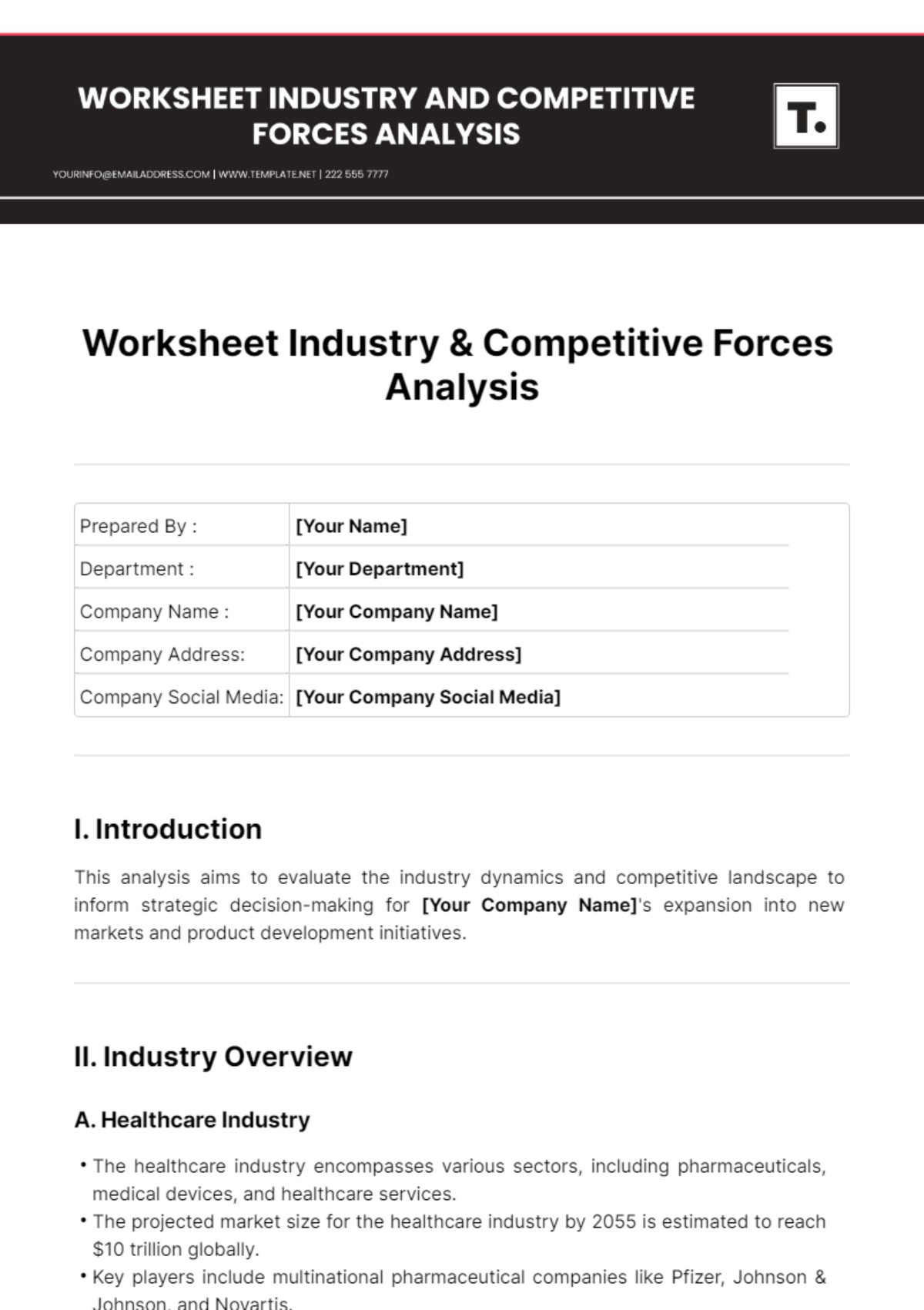Free Worksheet Industry & Competitive Forces Analysis

Prepared By : | [Your Name] |
Department : | [Your Department] |
Company Name : | [Your Company Name] |
Company Address: | [Your Company Address] |
Company Social Media: | [Your Company Social Media] |
I. Introduction
This analysis aims to evaluate the industry dynamics and competitive landscape to inform strategic decision-making for [Your Company Name]'s expansion into new markets and product development initiatives.
II. Industry Overview
A. Healthcare Industry
The healthcare industry encompasses various sectors, including pharmaceuticals, medical devices, and healthcare services.
The projected market size for the healthcare industry by 2055 is estimated to reach $10 trillion globally.
Key players include multinational pharmaceutical companies like Pfizer, Johnson & Johnson, and Novartis.
B. Market Trends
Advancements in telemedicine and digital health solutions are revolutionizing patient care delivery.
Increased focus on personalized medicine and gene therapy.
Regulatory reforms aimed at improving access to healthcare services globally.
Growing demand for healthcare services due to aging populations and the prevalence of chronic diseases.
III. Competitive Analysis
A. Competitor Identification
Major competitors in the pharmaceutical sector include Pfizer, Merck, and GlaxoSmithKline.
Local players such as [Local Pharma Company] also pose competition in specific markets.
Emerging biotech startups are disrupting traditional business models with innovative therapies.
B. Competitive Landscape
Pfizer's diversified portfolio includes blockbuster drugs like Celebrex and Zoloft, giving them a competitive edge.
Merck's focus on research and development has led to innovative treatments for various diseases.
GlaxoSmithKline's strong presence in emerging markets provides access to untapped opportunities.
[Local Pharma Company]'s agile approach allows them to quickly adapt to changing market dynamics.
C. SWOT Analysis
Strengths | Weaknesses | Opportunities | Threats |
|---|---|---|---|
Strong brand reputation | Reliance on a few blockbuster drugs | Expansion into emerging markets | Intense competition |
Extensive R&D capabilities | Patent expiration risks | Development of novel therapies | Pricing pressures |
Global distribution network | Regulatory hurdles | Strategic partnerships | Regulatory uncertainty |
Counterfeit drugs |
IV. Strategic Recommendations
A. Market Entry Strategies
Explore partnerships with local distributors to penetrate new markets in Asia and Africa.
Invest in research collaborations with academic institutions to drive innovation.
Acquire smaller biotech firms with promising drug pipelines to accelerate market entry.
B. Differentiation Strategies
Emphasize [Your Company Name]'s commitment to sustainability and ethical business practices.
Leverage digital health platforms to enhance patient engagement and outcomes.
Develop niche therapies targeting underserved patient populations.
C. Collaboration Opportunities
Form strategic alliances with biotech startups to access cutting-edge technologies.
Collaborate with healthcare providers to co-develop tailored solutions for specific patient populations.
Partner with governments and NGOs to improve access to essential medicines in underserved regions.
V. Conclusion
The worksheet industry presents viable opportunities for growth and expansion. By understanding the competitive forces and leveraging [YOUR COMPANY NAME]'s innate strengths, strategic positioning within this industry can be effectively enhanced and capitalized.
- 100% Customizable, free editor
- Access 1 Million+ Templates, photo’s & graphics
- Download or share as a template
- Click and replace photos, graphics, text, backgrounds
- Resize, crop, AI write & more
- Access advanced editor
Introducing the Worksheet Industry & Competitive Forces Analysis Template from Template.net, your strategic companion in market analysis. Fully editable and customizable, it provides a structured framework to dissect industry trends and competitive landscapes. Tailor analyses effortlessly to fit your business objectives, ensuring actionable insights and informed decision-making. Stay ahead of the curve with this essential tool guiding your journey toward industry dominance.





























